Ross Willmott
Richard III, Cardinal Wolsey an unlikely connection?
8th February, 2013
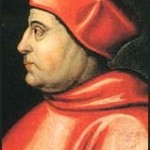
Now that the mortal remains of Richard III have been found in the social services car park here in Leicester, will the search for Cardinal Wolsey begin? What is the connection between these two men?
In November 1530 Wolsey had been summoned by Henry VIII to return to London to stand trial for treason, and no doubt execution. He stopped for the night at Leicester Abbey and at about 8am on the morning of 29th November 1530 he died.
On a plaque marking his birthplace in Ipswich it says:
“Thomas Wolsey Cardinal Archbishop, Chancellor…..in his power and pride he ranked himself with princes and trod the ways of glory. In his fall he died a humble man at Leicester Abbey about the hour of Eight on the morning of November 29th 1530 and was there buried at dead of night.
There begins the mystery of the disappearance of Wolsey. Where was he buried? His Body has never been found. Did he die? Was his death an invention to escape Henry’s anger and certain execution?
Perhaps we should follow in the footsteps of those who have discovered Richard III? Wolsey must be seen as Leicester’s other famous missing person. Although not a King his life and career at court were long and very eventful making him equally as interesting as Richard (see below).
Interestingly Thomas Wolsey’s father was Robert Wolsey, a man once thought to have been a butcher but who is now thought to have been a cloth merchant who was killed at the Battle of Bosworth. I can find no record of which side he fought on.
Connections?
Wolsey was about 12 years old when Richard III was killed by Henry Tudor later Henry VII
Wolsey may never have risen to prominence without the patronage of the Tudor kings Henry VII & VIII. The Tudors may not have been monarchs without the death of King Richard.
Wolsey worked for King Henry VII, as his royal chaplain
It is believed that Wolsey’s father, Robert, fought and died at the battle of Bosworth.
Both led lives of political intrigue and treachery that affected the course of history
Both Richard Plantagenet and Thomas Wolsey were buried in Leicester just over a mile apart. Both remained undiscovered for nearly 500 yrs. Richard has now been found.
Archaeology
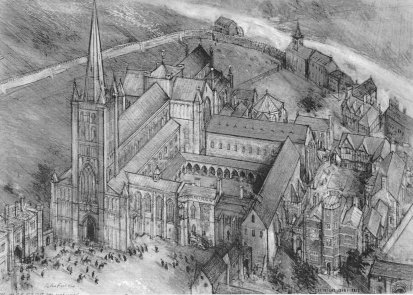
There have been many excavations of the Abbey site but none have found his tomb. The most comprehensive publication is Leicester Abbey Edited by J.Story, Jill Bourne and Richard Buckley. Pages 2-6 discuss Cardinal Wolsey and the first recorded excavations in the seventeenth century. These relate the supposed discovery of Wolsey’s bones by the Countess of Devonshire’s gardener and her instructions that they be covered up and not disturbed. “The impetus for such work was no doubt the promise of treasure” the writers reveal. There were reports that the cardinal had been buried with a considerable quantity of riches. Needless to say none have been found and it seems unlikely that if there were any that they would have remained hidden for long.
The details of the excavation of Richard III and the Priory of the Grey Friars where is was buried can be found on the excellent University of Leicester Website.
Thomas Wolsey’s Life 1473? -1530
Wolsey’s Rise
Thomas Wolsey was born around 1473 in Ipswich, Suffolk, and was the son of Robert Wolsey, a man once thought to have been a butcher but who is now thought to have been a cloth merchant who was killed at the Battle of Bosworth. Wolsey was educated at Ipswich School and then Magdalen College (Oxford University). Henry VII made him his Chaplain and his life became entwined with that of the Tudors.
Henry VIII came to the throne in 1509 and the new king recognised Wolsey’s intelligence and his skills and made him his almoner, a position which gave him a place on the King’s Privy Council. In 1511, Wolsey was made Canon of Windsor then Bishop of Lincoln and, in 1515, Wolsey was appointed Lord Chancellor after William Warham, the Archbishop of Canterbury, resigned. Around the same time, Pope Leo X made him a cardinal.
Wolsey showed Henry VIII just how indispensable he was during the 1512-14 war with France, revealing what a talent he had for foreign diplomacy. The second campaign against the French was successful due to Wolsey’s planning and the subsequent peace negotiations, which saw Mary Tudor marry the French King, Louis XII, were all part of Wolsey’s handiwork. Pope Leo X recognised Wolsey’s skills in this area and made him Papal Legate in 1518, which saw Wolsey negotiating the Treaty of London between twenty nations. In 1520, Wolsey organised a lavish meeting between Henry VIII and Francis I, the French King, at The Field of the Cloth of Gold and very soon he had got England to the enviable position of having the major powers of France and Spain fighting to be England’s ally. He was rewarded by the Pope for his skills and hard work in Europe in1523 when he was made Bishop of Durham.
Between 1527 and his death in 1530, Cardinal Wolsey was trying his utmost to get his master, King Henry VIII, an annulment of his marriage to Catherine of Aragon. Henry wanted his cursed marriage annulled so that he could marry again and hopefully have a son. By 1527, Henry even had another woman in mind, Anne Boleyn.
Annulment proceedings began in 1527 and Wolsey fought the case firstly by pointing out to the Pope that the original dispensation for Henry and Catherine’s marriage was invalid because the marriage was against Biblical law. After long delays orchestrated by Catherine and failure to convene the trial, Wolsey failed in his mission.
Wolsey’s Downfall
Henry VIII had been expecting the Legatine Court to rule that his marriage to Catherine was null and void, so it was a bitter disappointment when the court was adjourned and then news reached him that the Pope had approved Catherine’s appeal. However, although many people believe that it was Wolsey’s failure to get the King his divorce which was solely responsible for the Cardinal’s downfall, Eric Ives points out that Wolsey “lost Henry’s confidence from late August onwards by miscalculating the king’s mood and by mishandling the Treaty of Cambrai, in which Francis I totally deceived him and caused him, in turn, to mislead his master.” Wolsey’s mistakes, combined with his failure to get Henry his much-needed annulment, enabled the Boleyn faction to “bring him down”. Wolsey began to fall in favour as the likes of Norfolk, Suffolk and Rochford rose in favour and Wolsey was painted as a man who had not only sought to delay Henry’s marriage to Anne Boleyn, but also as a man who was “in the pocket of Francis I’s mother and mentor, Louise of Savoy” and so was not working for England’s best interests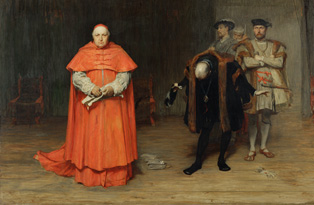
On the 9th October, Wolsey found himself being charged with “praemunire” which is described by Webster’s Dictionary as being “the offense of introducing foreign authority into England”. Around a week later, Wolsey was forced to hand over his seal of office and on the 22nd October 1529 he pleaded guilty to the charge of praemunire and surrendered all of his property to the King. Henry, however, secretly kept in touch with his former chancellor and Wolsey was fully pardoned and restored to Henry’s favour on the 12th February 1530.
On the 1st November a groom of the King’s chamber was sent to York, where Wolsey was staying, with a warrant for the Cardinal’s arrest. Henry VIII believed that Wolsey had “intrigued against them, both in and out of his kingdom” and entered into “presumptuous sinister practices made to the court of Rome for reducing him to his former estates and dignity”, treason in other words. On the 4th November, Wolsey was arrested while he was eating dinner and was made to set out for London to be tried for treason. J J Scarisbrick writes of how Wolsey’s natural death at Leicester Abbey on the 29th November 1530 “cheated his master of the final reckoning”, Wolsey had avoided the axeman and died in in a place of God, his true master. His successor, Thomas Cromwell, was not so lucky.
A fuller account from which this is taken can be found here
Cardinal Wolsey Statue in Abbey Park
Richard III Statue Castle Park
Comments
-
Hi Kim, I’ve been busy with family stuff but I just wnated to jump in and say….YUMMM I rented the first season and wow is it good. I grew up with Charles Laughton as Henry so I really wnated to see what they would do with someone who is…well…frankly, yummy. The costumes are so fabulous and I am interested to see what they will do to age him as history moves along. Charles Laughton he’s not!Did you happen to catch the BBC wives of Henry 8th this past winter? I enjoyed that as well.Hope you and yours are well.
-
Why, why, why? Think about what you are suggesting. Exhumation according to celebrity status to boost tourism, Perhaps some phone voting to see who the public would like to see next? Is it safe to be buried in Leicestershire? Cardinal Wolsey is a fascinating character, but we can be fascinated without seeing his bones. “Lost” King Richard was buried in the chancel of a church. “Finding” him is an event gifted by poor record keeping and disregard of consecrated ground.
-
An excellent idea – this has remained a mystery and maybe can now be investigated and solved.
-
Interesting. Have shared this on my Facebook Virtual Surgery as there are a number of people who are interested in local heritage.
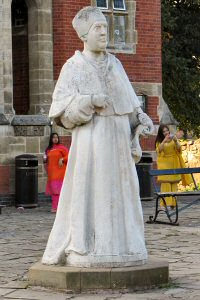
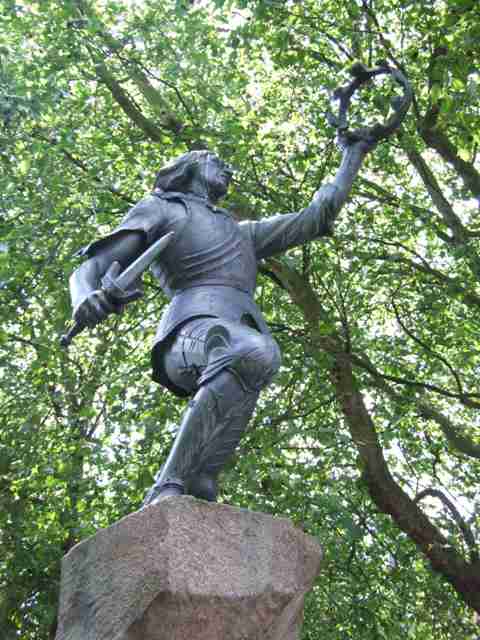
Leave a comment